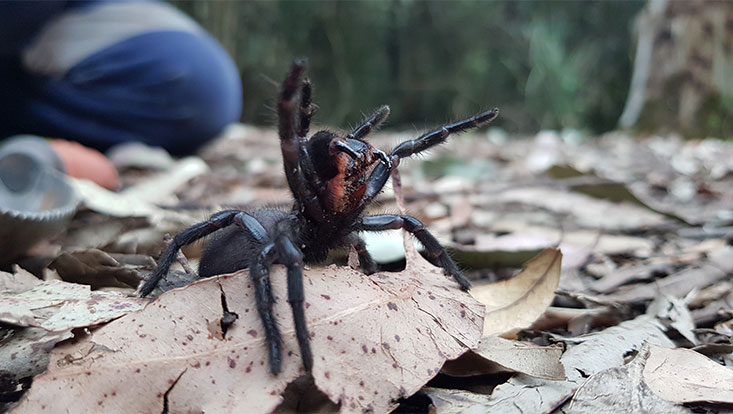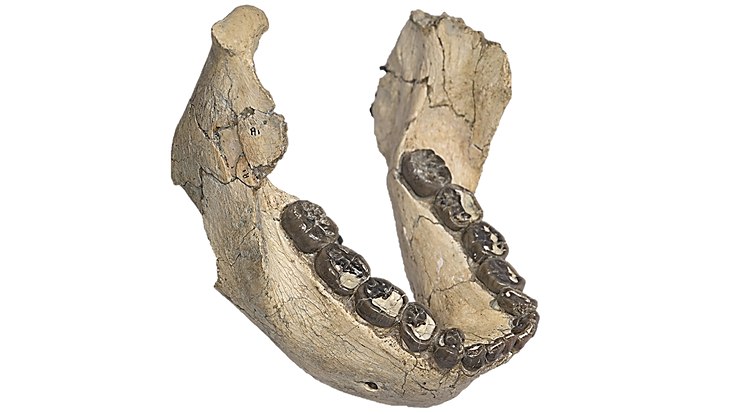
Research on the World’s Most Venomous Spider
7 May 2020

Photo: Peter Michalik, Universität Greifswald
The venom of this funnel-web spider is well studied, but almost nothing is known about its biology, genetics, and distribution.
According to the Guinness Book of World Records, this is the most dangerous spider in the world—its venom can kill people in less than an hour. And its sharp fangs are larger than those of some snakes. The Sydney funnel-web spider (Atrax robustus) lives in the middle of the Australian metropolis Sydney. This inevitably leads to threatening encounters between the spider and humans. But still little is known about the distribution of this species and how far it can disperse. Danilo Harms, a spider expert at CeNak, has started a project to explore this funnel-web spider and has just recently returned from his time in Australia—which went a little differently than planned.
“Am I glad to be back from Australia!” Danilo Harms didn’t just have to struggle with the aggressive male funnel-web spiders who kept losing the trackers that he and his colleagues from Sydney’s Macquarie University were using to explore the movement of the spiders. The nights were also cold and rainy and the spiders barely came out into the open. And then the coronavirus pandemic spread worldwide. Together with his team of students, he had to return to Hamburg early, somewhat rushed and by way of detours.
“Despite all the difficulties, we were able to complete our field research,” says Harms. This first research trip focused on morphological work with the funnel-web spiders from the Australian Museum’s collections in Sydney. “We spent the nights on the trail of the spiders, and during the day we worked at the museum,” says Harms, describing his daily research. Both the Australian Museum and Macquarie University are partners for this project, which is funded by a National Geographic Society grant program.
In the research on the behavior and genetic structure of the funnel-web spider, scientists focus on the males, which are significantly larger than the females and, more importantly, more aggressive and toxic. The females also have a powerful bite, but their venom doesn’t include the strong neurotoxin, which is so dangerous for humans. When males leave their caves during mating time and make their way through the city of Sydney, showing up at swimming pools and other places or hiding in shoes, they come threateningly close to people. Up to 40 people are bitten every year and have to go to the hospital to be treated with intravenous antivenom.
“The venom of the Sydney funnel-web spider is well studied, but almost nothing is known about its biology, genetics, and distribution,” says Danilo Harms. “The taxonomy is also shaky. This means that the most deadly spider could actually be a species complex of several externally similar species—each with its own venom and individual preference for habitats.
Current information shows that the funnel-web spider lives within the radius of Sydney’s metropolitan area, but there are no records with more specific information about the population structure. Harms comments, “By using tracking technology to observe the males, we want to find out how and when these animals come into contact with humans. We would like to learn more about how they wander, how far individual animals can travel, and where the main populations are located. Using genetic analysis, we are able to determine how many different species there are. We also hope to help conserve this extraordinary species, whose habitats are threatened by Sydney’s urban sprawl.Danilo Harms and his students Ricardo Lou and Svea-Celina Frank plan to finish processing the data they collected in Australia by the end of the year. Then the plan is to head back to the field!
Contact
Dr. Danilo Harms
Head of the Department of Arachnology
Center of Natural History (CeNak)
Universität Hamburg
Tel: +49 40 42 838-5983
Danilo.Harms@uni-hamburg.de(Danilo.harms"AT"uni-hamburg.de)


